Friends of the Hollywood Central Park Board of Directors
FHCP Staff
-
Philip E. Aarons, Chairman
-
Alfred Fraijo, Jr., President
-
George Abou-Daoud, Vice President
-
Jeffrey Briggs, Vice President
-
Brian Folb, Vice President
-
Scott Campbell, Treasurer
-
Christi Van Cleve, Secretary
-
Christopher Barton
-
Douglas Campbell
-
Heather Cochran
-
James Feldman
-
Betty Fraser
-
Craig Fry
-
David Gajda
-
Terri Gerger
-
Aileen Getty
-
Bradley Glenn
-
John Goodwin
-
David Green
-
Phil Hart, PhD
-
Ed V. Hunt
-
Tricia LaBelle
-
Jacob Lipa
-
Stacy Marble
-
Timothy McOsker
-
Susan Polifronio
-
Sharyn Romano
-
Marie Rumsey
-
Scott Rynders
-
Nicole Shahenian
-
Dixon Slingerland
-
Thaddeus Hunter Smith
-
Robert Soderstrom
-
Gary Taglyan
-
Adam Tartakovsky
-
Todd Warner
-
Laurie Goldman
Executive Director
-
Alfredo Hernandez
Program Director
FHCP received award for Public Open Space (in process) and People’s Choice Award at Westside Urban Forum’s Annual Design Awards Luncheon on June 5th.
I ♥ Hollywood Central Park
Show your support for your Hollywood Central Park Give us a positive review at: Great Non-Profits
|
 |
In this issue:

By FHCP’s President Alfred Fraijo, Jr. and Executive Director Laurie Goldman
From our first trip to DC in 2007 to our most recent trip in May, FHCP’s engagement in substantive conversations at every level of government yields positive results which we transform into action.
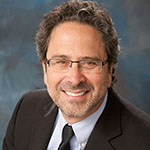
By Assembly Member Richard Bloom
The City of Los Angeles and the neighborhood of Hollywood are currently considering a vast upgrade of their park system.

The Palladium Residences is a proud FHCP sponsor and we look forward to making the Hollywood Central Park a reality together with our community partners.
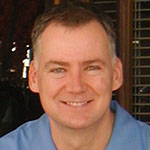
Executive Director Laurie Goldman sat down with FHCP Founding Board Member and Treasurer, Scott Campbell for a discussion on all things Hollywood.
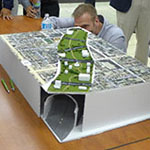
FHCP is dedicated to working with students of all ages to enhance their education, inspire their imagination and ignite their passion.By Alfredo Hernandez, FHCP Program Director
Washington DC – Why we go
By FHCP’s President Alfred Fraijo, Jr. and Executive Director Laurie Goldman
FHCP goes to Washington DC to:
-
Access information and services that we can use to develop, plan and design the Hollywood Central Park
-
Understand the vast number of existing programs and policies that can benefit the Hollywood Central Park
-
Share our progress with the administration, agencies and elected representatives
-
Initiate a conversation to change “what is” into a “what should be”
-
Recommend a course of action to benefit the stakeholders of our community
From our first trip to DC in 2007 to our most recent trip in May, FHCP’s engagement in substantive conversations at every level of government yields positive results which we transform into action.
FHCP goes to Washington DC because civic engagement is an essential component of our mission. As part of our strategy to create change we must engage the state and federal legislative processes.
Our meetings with the Department of Transportation are a case in point. Initially, DOT was not warm to the idea of a cap park over US 101 even though they worked with Seattle on the nation’s first cap park in 1976. It was difficult for an agency dedicated to transportation to understand the Park as a transportation project. It took many years of HCP progress, discussion, a change in leadership and shift in policy to gain DOT’s support. At our 2012 DOT meeting, former DOT Secretary Ray LaHood stated “Highways are scars on the landscape of America, decking our highways would be a positive step toward healing those scars.” This past May at a meeting with Deputy Secretary Victor Mendez, we discussed DOT’s commitment to livability and sustainability and their Grow America program. DOT is committed to place-making and the kind of smart growth that creates livable development.
DOT Secretary Foxx wrote the following in his Fast Lane blog on June 3, 2015, “I've said repeatedly that transportation should not create division; it should be the solution to past divisions. We've had a historic approach that emphasizes throughput --speeding people from one community through, over, or around another community-- usually by building a highway that actually isolates local residents from the jobs and other activities in a downtown business district. I've seen the consequences of throughput, the thwarted access to opportunity.”
Another illustration of why we go to DC can be found in our meetings with elected representatives.
Representative Adam Schiff, CA 28, is a perfect example. Since becoming HCP’s representative, Rep. Schiff has been a steadfast supporter. He has arranged meetings with FHWA, various agencies and his colleagues, all in an effort to advance our project forward with best practices. In a meeting with his colleague Representative Raul Grijalva, AZ 3, ranking member of the House Natural Resources Committee, we discussed NEPA’s social justice component, Title VI of the Civil Rights Act of 1964, and the President’s Executive Order 12898 on environmental justice and health.
With more than 150 cap parks in the United States, meeting with representatives who have cap parks in their districts provides a diversity of ideas, tools, and practical advice that adds to FHCP’s knowledge base and will only make the Hollywood Central Park a better project for the community it serves.
FHCP goes to Washington DC to make progress.
If you are interested in joining our annual trips to Washington DC and Sacramento, please contact Alfredo Hernandez at alfredo.hernandez@hfcp.org
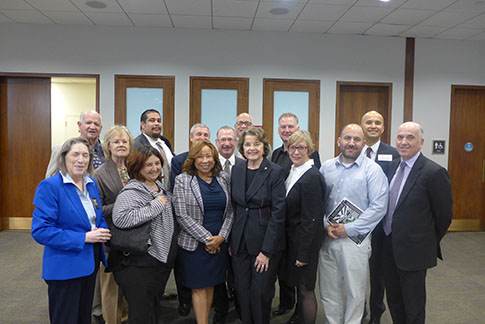
l-r front row Sharyn Romano, Martha Hunt, Nicole Shahenian, Tanya Hart, Senator Dianne Feinstein, Laurie Goldman, Michael LoGrande and Jacob Lipa
l-r back row Edward Hunt, Alfredo Hernandez, David Green, Brian Folb, Phil Hart, Scott Campbell and Alfred Fraijo, Jr.
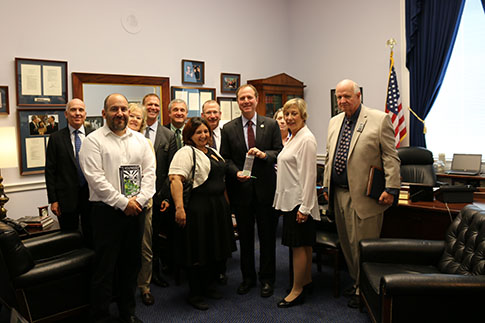
l-r front row Michael Lo Grande, Nicole Shahenian, Representative Adam Schiff, Laurie Goldman and Edward Hunt
l-r back row Jacob Lipa, Martha Hunt, Todd Warner, David Green, Brian Folb, and Sharyn Romano
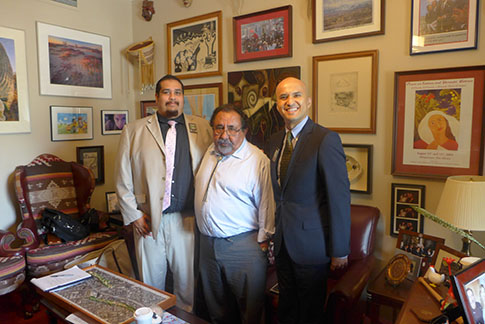
l-r Alfredo Hernandez, Representative Raul Grijalva and Alfred Fraijo, Jr.
Hollywood’s Central Park, Affordable Housing and Our Quality of Life
By Assembly Member Richard Bloom
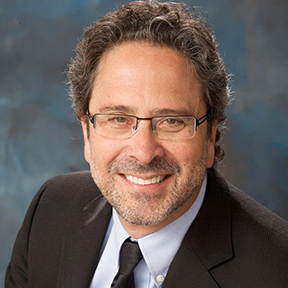 The City of Los Angeles and the neighborhood of Hollywood are currently considering a vast upgrade of their park system. The vision is for a large urban “Hollywood Central Park” along the 101 Freeway that would rival Central Park in New York, Golden Gate Park in San Francisco or Rock Creek Park in Washington, DC. As the former mayor of Santa Monica and a longtime advocate for open space, I strongly support the concept. Upon completion, this new park would deliver large-scale recreational areas for Hollywood’s families, attract new investment in the area, create jobs and improve the environment in many ways. By incorporating what we’ve learned from other projects around the country, we can preserve existing and create new affordable housing in the immediate vicinity. The City of Los Angeles and the neighborhood of Hollywood are currently considering a vast upgrade of their park system. The vision is for a large urban “Hollywood Central Park” along the 101 Freeway that would rival Central Park in New York, Golden Gate Park in San Francisco or Rock Creek Park in Washington, DC. As the former mayor of Santa Monica and a longtime advocate for open space, I strongly support the concept. Upon completion, this new park would deliver large-scale recreational areas for Hollywood’s families, attract new investment in the area, create jobs and improve the environment in many ways. By incorporating what we’ve learned from other projects around the country, we can preserve existing and create new affordable housing in the immediate vicinity.
Most would agree that new urban parks improve our quality of life. A good example of this is Chicago’s urban Garfield Park, which stimulated investment and development in the surrounding neighborhoods, engaged numerous citizens from all demographics, and helped lay the groundwork for other successful community organizing efforts.
Proper planning by city leaders will help insure that the new park does not lead to unwanted gentrification. A balance must be drawn between improving our neighborhoods while avoiding making them exclusive. University of California, Berkeley Professor of Design, Jennifer Wolch, has pioneered a concept entitled “Just Green Enough” that prevents gentrification by encouraging neighborhoods to keep their existing, often industrial, character. We can and should ensure that new housing be set aside for low-income and middle class residents. Incorporating facilities in the park that appeal to all demographics is also crucial to preventing excessive gentrification. Baseball diamonds, soccer fields, and basketball courts are just some of the important elements that will appeal to everyone, particularly families.
Lastly, we must do everything possible to maximize community input so that existing residents know that Hollywood Central Park is, and will always be, their park. It is no secret that community advocacy is the key to leveraging public and private funding. Having neighborhood associations, churches, synagogues, and other community groups engaged with their city, county and state officials will be critical to ensuring that the park design reflects the needs of all of the surrounding residents.
How to balance urban improvements and business investment with opportunities for the working classes is the key task facing almost every American city today. Washington, DC has embarked on a plan called “revitalization without gentrification” to rebuild one of their most blighted areas. The plan calls for building new housing, a new recreation center, a computer lab and a school. They are also promising that local residents will get first options to move into the units in an effort to attain zero displacement. While this project has just started, it imitates other projects that balance growth and preservation such as Melrose Commons in the South Bronx and Cully Main Street in Portland, OR.
According to Catholic University Professor Hazel Edwards, the key to successful balanced projects is “bringing residents and the community to the table often and at the beginning”. The Friends of Hollywood Central Park are working hard to do just that. Through an innovative program designed uniquely for this proposal, users have been able to create and submit their own versions of the park, choosing many possibilities for design and features
By continuing to follow these and similar principles, the proposed Hollywood Central Park will greatly improve the quality of life in the area, while preserving the affordable housing for current residents.
California State Assemblymember Richard Bloom represents California’s 50th Assembly District, which includes much of Hollywood, West Hollywood, West Los Angeles, Beverly Hills, Santa Monica, Pacific Palisades and Malibu. The proposed Hollywood Central Park lies partially within Assembly District 50. Bloom chairs the Assembly Budget Subcommittee on Resources and Transportation, is a member of the Committee on Transportation, Select Committee on California’s Clean Energy Economy, Select Committee on Homelessness, and Select Committee on Urban Planning and Land Use in Underserved Communities. He is a former Mayor of Santa Monica, California.
And now, a word from our Sponsors ...
The Palladium Residences
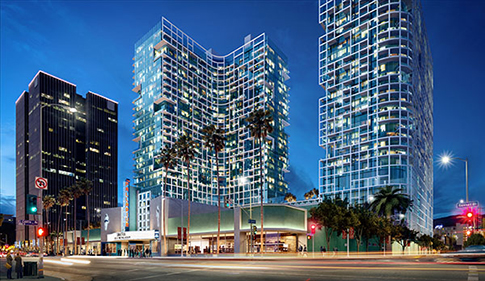
The Palladium Residences is a proud FHCP sponsor and we look forward to making the Hollywood Central Park a reality together with our community partners. As we plan for the future of Hollywood and the Park, we must also recognize our neighborhood’s unique history. 2015 marks the 75th anniversary of the iconic Hollywood Palladium and we are excited to celebrate the occasion with everyone later this year!
The Hollywood Central Park will be a landmark and incredible resource for generations of Hollywood residents to come. The Palladium Residences will similarly preserve the historic Palladium, where we were honored to host FHCP’s 2015 “For the Love of Hollywood” annual gala this January. Truly a one of a kind project, the Hollywood Central Park represents a smart investment in our community. We believe our tenants will make good use of the Central Park. These two improvements will allow us to live, work and play in our own neighborhood.
The Park’s more than 38-acres of green space will be a significant quality of life improvement for the greater Los Angeles region, attracting new and diverse visitors to the site of a “former” freeway. The Palladium Residences will follow the Hollywood Central Park’s green example and enliven a block of Sunset Boulevard dominated by asphalt parking lots with 30,000+ square feet of ground-level open space in new pedestrian courtyards -- public spaces filled with trees and landscaping.
The Palladium Residences applauds the Friends of the Hollywood Central Park for their leadership and contributions to our community.
Getting to Know You: Scott Campbell
Fourth in a series of interviews with the FHCP Board of Directors
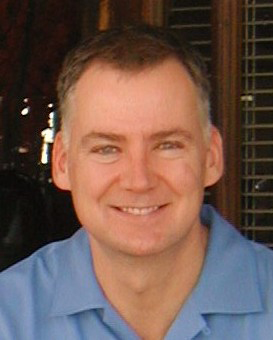
Scott Campbell, FHCP Founding Board Member and Treasurer
Scott attended Pepperdine University while working for a small Real Estate office in Malibu. After graduating from Arizona State University with a B.A. in Management, minor in Real Estate, he worked in corporate America for many years: Commercial Finance, Banking, and Insurance. Scott began his most recent California Real Estate Career with a large regional company. After several years there, he joined a smaller firm for two years before becoming a proud founding member of the Nourmand & Associates Hollywood Office.
Scott feels it is important to give back to the community. He is President of Hollywood Network Coalition, Past President of Central Hollywood Neighborhood Council, and has been on the boards of two other neighborhood councils. He is a Founding Board Member and Treasurer of the Friends of the Hollywood Central Park, whose mission is to create a 38 acre park in Hollywood over the 101 Freeway.
Scott lives in a 1920’s Craftsman home in Hollywood with his partner, a screenwriter, and their dogs, Malibu and Venice.
Executive Director Laurie Goldman sat down with FHCP founding Board Member and Treasurer, Scott Campbell for a discussion on all things Hollywood:
LG: Scott, you are President of Hollywood Network Coalition, a member of FHCP Board, past president of Central Hollywood Neighborhood Council among so many other organizations – what drives you to be so involved in your community?
SC: I started volunteering in my neighborhood in Phoenix long before I moved to Hollywood. It all starts in wanting to make where I live a better place for me to live, helping my property value, and making the community a great place for others to live. I also like to know what’s coming next and getting involved helps me learn that. So, while not completely altruistic, good things happen as a result.
LG: As a founding Board Member, please share with our readers how and why you chose to get involved with the Hollywood Central Park?
SC: As an involved community member, how could I NOT be involved? You know better than anyone the transformative power this project will have on so many aspects of our community. It’s one of those things that you’re lucky if it comes along once in a lifetime. I’m so proud to be a part of it.
LG: The primary goals of the Hollywood Central Park are to unite communities separated for more than 60 years by the construction of the Hollywood Freeway and to provide the disadvantage communities surrounding the freeway with green open space. With your extensive background in real estate, how do we simultaneously preserve affordable housing, create new affordable housing and stimulate the local economy through development?
SC: What we’ve seen as we research other parks of this sort is that local development increases and economic boon is a given. Just the existence of the park itself encourages development. The key is preserving and creating affordable housing. Incentives already in place will help drive creation of new affordable housing. However, I think the City can do more by requiring, at a minimum, replacement of affordable units that will be lost to make way for development and requiring affordable housing in any residential development. The best thing we could do to preserve affordable housing is to act NOW to buy existing units to maintain as affordable units, perhaps with incentives, donations, help from non-profits, etc.
LG: As a community of residents and businesses, what can we do to create a common vision for the future of Hollywood?
SC: Communication is vital. When I was President of the neighborhood council, I reached out to businesses, both individually and to organizations like the Chamber and the BIDs, to work together on vetting projects that benefitted the community at large while respecting the neighborhoods. I sat on the Economic Development Committee, I attended Design Review, and coordinated with BID leadership while on the neighborhood council. Bottom line is that we all want a livable community. Livability works best for both residents and businesses. We need to discuss the concerns of all parties and balance them with the desire (and need) to make money, foster development, and accept that progress is not bad. While the neighborhood council system has perhaps run its course, there are other organizations that actually represent the community, like the Hollywood Network Coalition, and can speak from experience about Hollywood.
LG: Throughout your many years as both a Hollywood resident and president of a neighborhood council, what changes have you seen in Hollywood that are worthy of celebration? What changes have yet to be realized?
SC: The evolution of the Park from an idea to a ‘real project’ is the biggest reason to celebrate. The Red Line is another huge asset. There are many developments and redevelopment that brought back the entertainment industry with new office space and residents around transit corridors. The community banded together to clean up neighborhoods street by street with neighborhood watches. Conversely, we have a Walk of Fame that attracts people from all over the World that is still too dirty, we need development and revitalization in the middle of Hollywood Blvd to connect the ends, we need a traffic plan that gets people where they want to go without going through stop and go traffic in Hollywood, and we need to keep working on our homeless issues. Great work is being done on all of these challenges and needs to continue.
FHCP: Working with Students of all Ages
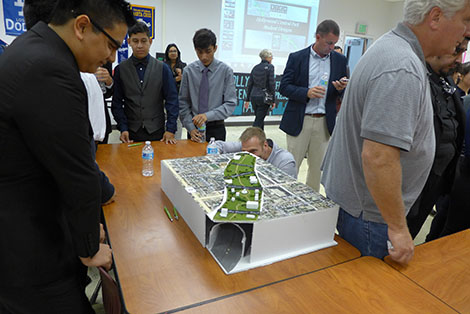
FHCP is dedicated to working with students of all ages to enhance their education, inspire their imagination and ignite their passion. By using the Hollywood Central Park as their foundation, students explore, develop and test ideas and concepts to enrich the Hollywood Central Park experience. Our collaboration results in reimagining the park, open green space and sustainability. The following stories detail our work with the STEM Academy @ Bernstein and UCLA’s IDEAS curriculum:
By Alfredo Hernandez, FHCP Project Director
STEM Academy @ Bernstein – 9th Grade Presentations
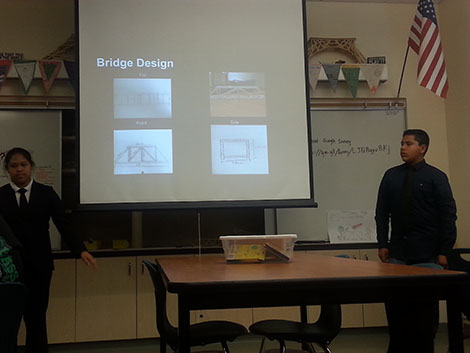

9th Grade Student explains the Triangle Design and why it works best for pedestrian bridges.
All 9th Grade STEM classes presented their pedestrian bridge designs, planned to connect sections of the Hollywood Central Park, to a panel of judges – including Alfredo Hernandez, FHCP’s Project Manager. The bridge designs considered environmental impact, building materials, cost and the overallbridges’ ability to bear weight. On May 7th, under the direction of teacher Amy Tsang, a dozen 9th Grade teams proudly displayed their bridge concepts that included designs constructed from wood, stainless steel and cement. The varied pedestrian bridge designs included the four basic types of bridge design: suspension, truss, cantilevered and arch.
STEM Academy @ Bernstein – 11th and 12th Grade Presentations

FHCP Board Member Todd Warner examines the 3D printed model of the Hollywood Central Park designed by the STEM Academy 11th and 12th grade students. (above) FHCP Executive Director Laurie Goldman and Council District 13 Field Deputy Dan Halden pay close attention to the students presentations. (below)
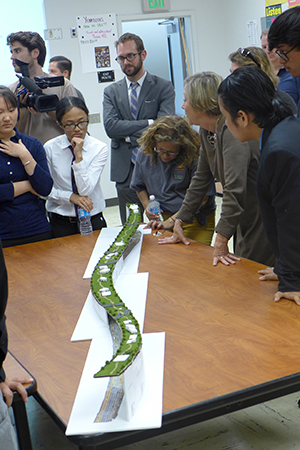 Under the direction of STEM teacher Katherine Simon, the junior and senior classes spent a semester responding to a “faux” Request for Proposal (RFP) to design the Hollywood Central Park. Each of three teams was tasked with creating their own engineering and design firms to craft their response, which focused on environmental sustainability and cost control. Each team created a company name apropos of the Hollywood Central Park: Insert Team Names. Teams used Auto-CAD to design their parks, Google Sketch-Up to prepare renderings and also filmed a documentary video of their work. Under the direction of STEM teacher Katherine Simon, the junior and senior classes spent a semester responding to a “faux” Request for Proposal (RFP) to design the Hollywood Central Park. Each of three teams was tasked with creating their own engineering and design firms to craft their response, which focused on environmental sustainability and cost control. Each team created a company name apropos of the Hollywood Central Park: Insert Team Names. Teams used Auto-CAD to design their parks, Google Sketch-Up to prepare renderings and also filmed a documentary video of their work.
On May 26th, a panel of judges which included FHCP Board members Scott Campbell, Brian Folb, Phil Hart, Susan Polifronio, Christi Van Cleve and Todd Warner, along with Executive Director Laurie Goldman and Project Manager Alfredo Hernandez, reviewed the students’ remarkable work. (Renderings and documentaries may be found here on the FHCP website.)
This innovative class project allowed the students to apply their classwork, learn new skills, and exercise their imaginations in furtherance of their goals and objectives to build a Hollywood Central Park. Their amazing work even received media attention from the LA Times in this delightful article by Nita Lelyveld.
FHCP is gearing up to work with the STEM Academy’s new class of 11th and 12th graders this Fall.
Crafting a Landmark
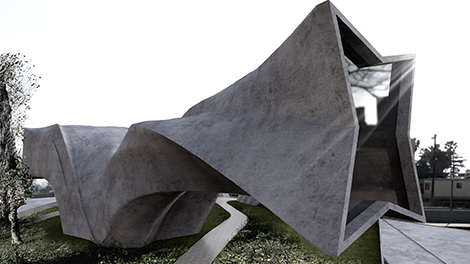
Joseph Sarafian is a UCLA Landscape Architecture Graduate student in the IDEAS program. Joey, as he prefers to be called, has taken on the task of creating a conceptual design for the proposed land-mass bridge over Hollywood Boulevard. While the Park has yet to be designed, the land-mass bridge is a possible idea to connect sections of the park and the north end. Below is Joey’s narrative describing his inspiration and design concept.
As a designer, I have often wondered why the space over freeways had never truly been utilized in Los Angeles. Ideas of parks, buildings, and community spaces would swim around behind my furrowed brow as I commuted to work Downtown every day. Fast forward to 2015. It was a typical day in grad school... while navigating Facebook posts, I came across the proposal for Hollywood Central Park and I was in love at first sight. "It's about time," I remember thinking. I was taking a course that tackled real life problems from other industries and applied an architectural solution to them. With the freedom to choose our topic, I knew I had found my site.
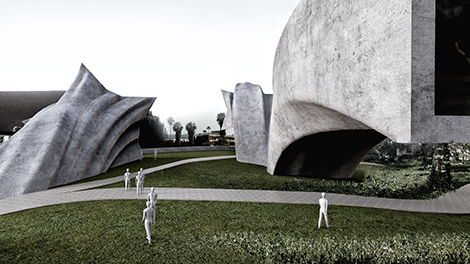
I chose to consider one of the more complex conditions that Hollywood Central Park proposed, yet had not yet solved. That area was where the park lifts over Hollywood Boulevard. At this location a restaurant was proposed to sit on the park above the street. I saw this not only as a complex set of design constraints, but as an opportunity for a civic landmark, a gateway to Hollywood. The design would have to allow light to penetrate through the floor of the park, down to Hollywood Boulevard and also allow a means of egress to and from the park. It also had to be structural. Taking all of these factors into consideration, I began working on the design, guided by my instructor Valerie Leblond and my peers who would comment on each stage of development.
Hollywood is obviously a complex community of both entertainment and urban culture. I took this juxtaposition as a design cue to integrate the glitz and glamour of Hollywood with the reality of Hollywood's various ethnic communities. After months of design iterations, the concept I arrived at was one of integrating the confluence of parameters into a singular solution. On the Hollywood side of the park, two star-shaped viewing portals reach out, looking out over Hollywood. These stars dip down through the park, past Hollywood Blvd. and rest on the 101 Freeway where they provide vertical structure and pedestrian circulation. They then lift up to emerge on the other side of the park (facing Western), except as they emerge, the stars have now transformed into picture frame windows. This metaphor alludes to the way in which the world perceives Hollywood (through the television screen). Skylights penetrate the park bringing natural light down onto Hollywood Blvd. and onto the 101. This design is theoretical, yet still ongoing.
|

